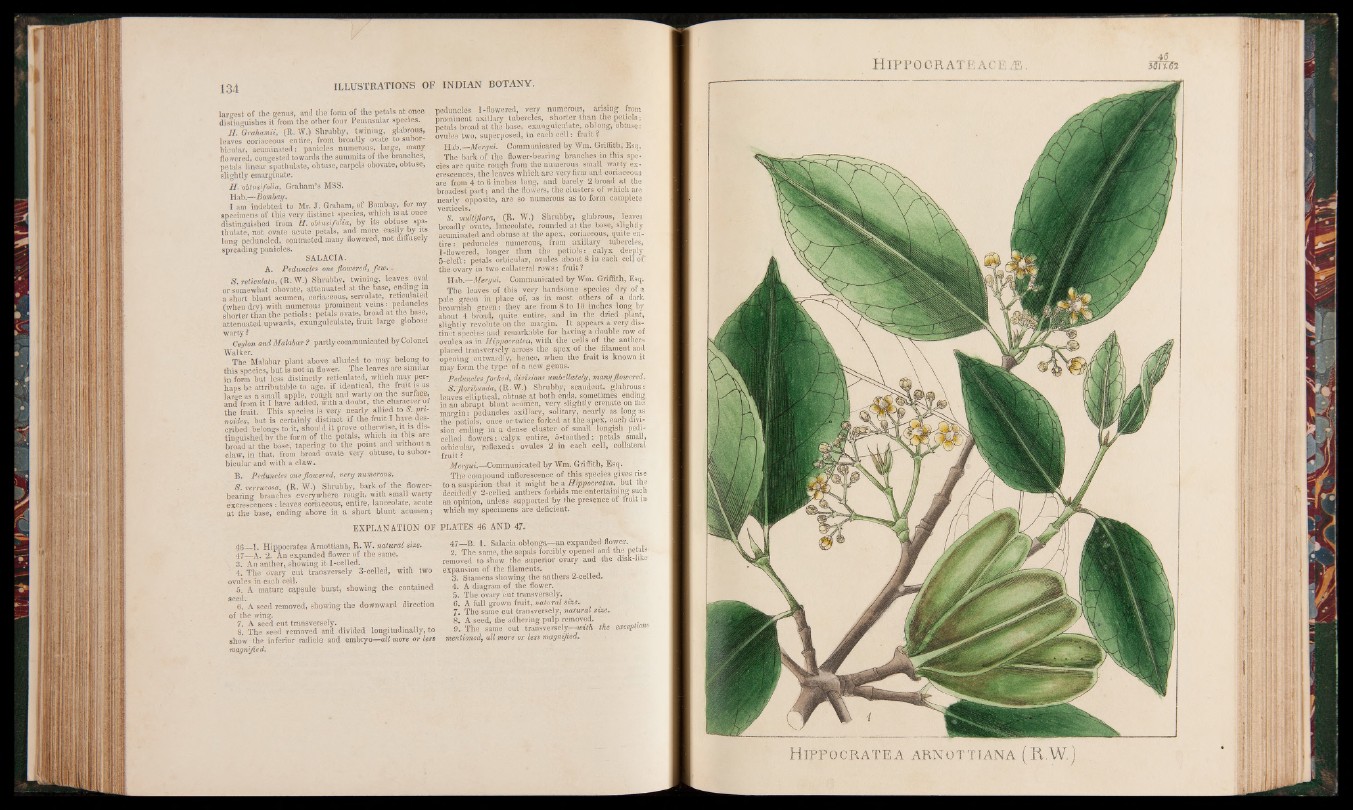
largest of the genus, and the form of the petals at once
distinguishes it from the other four Peninsular species.
H . Grahamn, (R. W.) Shrubby, twining, glabrous,
leaves coriaceous entire, from broadly ovate to subor-
bicular, acuminated: panicles numerous, large, many
flowered, congested towards the summits of the branches,
petals linear spathulate, obtuse, carpels obovate, obtuse,
slightly emaxginate.
H . obtusifolia, Graham’s MSS.
Hab.—-Bombay.
I am indebted to Mr. J. Graham, of Bombay, for my
specimens of this very distinct species, which is at once
distinguished from H. obtusifolia, by its obtuse spathulate,
not ovate acute petals, and more easily by its
long peduncled, contracted many flowered, not diffusely
spreading panicles.
SALACIA.
A. Peduncles one flowered, f e w . .
S . reticulata, (R. W.) Shrubby, twining, leaves oval
or somewhat obovate, attenuated at the base, ending in
a short blunt acumen, coriaceous, serrulate, reticulated
(when dry) with numerous prominent veins: peduncles
shorter than the petiols: petals ovate, broad at the base,
attenuated upwards, exunguiculate, fruit large globose
warty?
Ceylon and Malabar ? partly communicated by Colonel
Walker.
The Malabar plant above alluded to may belong to
this species, but is not in flower. The leaves are similar
in form but less distinctly reticulated, which may perhaps
be attributable to age, if identical, the fruit is as
large as a small apple, rough and warty on the surface,
and from it I have added, with a doubt, the character of
the fruit. This species is very nearly allied to S. prir
noides, but is certainly distinct if the fruit I have described
belongs to it, should it prove otherwise, it is distinguished
by the form of the petals, which in this are
broad at the base, tapering to the point and without a
claw, in that, from broad ovate very obtuse, to subor-
bicular and with a claw.
B. Peduncles one flowered, very numerous.
S. verrucosa, (R. W.) Shrubby, bark of the flowerbearing
branches everywhere rough, with small warty
excrescences: leaves coriaceous, entire, lanceolate, acute
at the base, ending above in a short blunt acumen;
peduncles 1-flowered, very numerous, arising from
prominent axillary tubercles, shorter than the petiols:
petals broad at the base, exunguiculate, oblong, obtuse:
ovules two, superposed, in each c e ll: fruit ?
Hab.—Mergui. Communicated by Wm. Griffith, Esq.
The bark of the flower-bearing branches in this species
are quite rough from the numerous small warty excrescences,
the leaves which are very firm and coriaceous
are from 4 to 6 inches long, and barely 2 broad at the
broadest part; and the flowers, the clusters of which are
nearly opposite, are so numerous as to form complete
verticels.
S. multiflora, (R. W.) Shrubby, glabrous, leaves
broadly ovate, lanceolate, rounded at the base,' slightly
acuminated and obtuse at the apex, coriaceous, quite entire
: peduncles numerous, from axillary tubercles;
1-flowered, longer than the petiols: calyx deeply
5-cleft: petals orbicular, ovules about 8 in each cell of
the ovary in two collateral rows: fruit ?
Hab.—Mergui. Communicated by Wm. Griffith, Esq.
The leaves of this very handsome species dry of a
pale green in place of, as in most others of- a dark
brownish green: they are from 8 to 10 inches-long by
about 4 broad, quite entire, and in the dried plant,
slightly revolute on the margin. It appears a very distinct
species and remarkable for having a double row of
ovules .as in Hippocratea, with the cells of the anthers
placed transversely across the apex of the filament and
opening outwardly, hence, when the fruit is known it
may form the type of a new genus.
Peduncles forked, divisions umbellately, many flowered.
STflofibunda, (R. W.) Shrubby; scandent, glabrous:
leaves elliptical, obtuse at both ends, sometimes ending,
in an abrupt blunt acumen, very slightly crenate on the
margin: peduncles axillary, solitary, nearly as long as
the petiols, once or twice forked at the apex, each division
ending in a dense cluster of small longish pedi-
celled flowers: calyx entire, 5-toothed; petals small,
orbicular, reflexed: ovules 2 in each cell, collateral
fruit ?
Mergui.—Communicated by Wm. Griffith, Esq.
The compound inflorescence of this species gives rise
to a suspicion that it might be a Hippocratea, but the
decidedly 2-celled anthers forbids me entertaining such
an opinion, unless supported by the presence of fruit in
which my specimens are deficient.
EXPLANATION OF PLATES 46 AND 47.
46— 1. Hippocratea Arnottiana, R. W. natural size.
47— A. 2. An expanded flower of the same.
3. An anther, showing it 1-celled.
4. The'ovary cut transversely 3-celled, with two
ovules in each cell. _
5. A mature capsule burst, showing the contained
seed. 1 *■
6. A seed removed, showing the downward direction
of the wing.
7. A seed cut transversely.
8. The seed removed and divided longitudinally, to
show the inferior radicle and embryo—all more or less
magnified.
47—B. 1. Salacia oblonga—-an expanded flower.
2. The same, the sepals forcibly opened and the petals-
removed to show the superior ovary and the disk-like
expansion of the filaments.
3. Stamens showing the anthers 2-celled.
4. A diagram of .the flower.
5. The ovary cut transversely.
6. A full grown fruit,.natural size.
7. The same cut transversely, natural size►
8. A seed, the adhering pulp removed.
9. The same cut transversely-—with the exception&■
mentioned, all more or less magnified
HIPPOCRATEAC
Hippocratea arnottiana (R.W.)